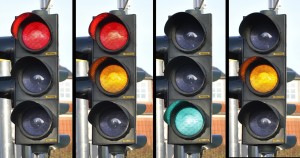Handling Intersections
Did you know that 40% of all accidents occur at intersections? An intersection is created any time two or more roads come together. They come in many different shapes and sizes with very specific rules of driver conduct. There are basically two types of intersections: 1. Controlled and 2. Uncontrolled.
Controlled and Uncontrolled Intersections
A controlled intersection is one that has a sign or light to help you navigate your travel. An uncontrolled intersection has no signs or lights to help assist you in your travels.
Uncontrolled intersections are usually found in rural and suburban areas. Human interaction has never become more crucial than at uncontrolled intersections. Sound judgement and the use of right of way laws are essential when dealing with these intersections. Maybe now you can see why there is such a high accident rate at these cross roads. Here are two basic rules for handling an uncontrolled intersection:
- A vehicle entering a major roadway from a driveway or alleyway must yield right of way to the traffic on the major roadway.
- Vehicles approaching an uncontrolled intersection at the same time must yield right of way to the vehicle on the right.
Handling a controlled intersection gets a little more complicated with the addition of signs and lights. Controlled intersections are more likely found in large towns and cities. They are further broken down into categories when you factor in the left hand turning aspect. A protected intersection has a green arrow to allow you to make a left hand turn while traffic is stopped on the opposite side of the intersection. An unprotected intersection has no arrow to “protect” your turn. Now this is where it can get ugly! New drivers can especially struggle with the handling of a unprotected intersection.
Driver Education for Unprotected Intersections:
Here is what you need to know:
- If you are waiting for traffic to clear and you see an opening pull under the light with your wheels straight (this way if you are hit from behind you will not be thrown into oncoming traffic). If the light happens to turn red over your head, right of way laws protect you and you may complete your turn ( a car in the intersection has the right of way over a car preparing to enter).
- If the light is red when you are approaching the intersection make sure you are in the proper turning lane and stop behind the stop line or cross walk if there is one. Next wait for the light to change to green and move under the light and wait for enough clear space to complete your turn. Again keep your wheels straight as you wait to turn.
- If the light is green when you approach the intersection you have a decision to make a. if there is only a small amount of traffic move into the intersection and wait until traffic is clear or b. if there is a lot of traffic stay back behind the stop line or cross walk and wait for the next cycle of lights. Once the light turns green again pull under the light and wait for your clear space to turn.
Other Right of Way Laws to Be Concerned About:
- A car going straight ahead has the right away over a car turning left.
- Fire engines, police cars and all other emergency vehicles Have the right of way over all traffic. (You must move over to the right side of the road and slow down or stop to allow them to pass).
- Pedestrians in cross walks have the right of way over all vehicles. (Pedestrians basically have right of way any time they are in the street)
- A car in the traffic circle has the right of way over a car trying to enter.
- At a four way stop the car that arrives first gets to proceed first. if two cars arrive at the same time the car on the right should proceed first.
Understand that right of way is a code of conduct that a driver may have to give up for safety reasons. Many people do not know them or understand them.
Sign up for our FREE “Guide to Passing the Road Test” on the side bar! Also check out our Resources page for tons of helpful Driver Education materials.

